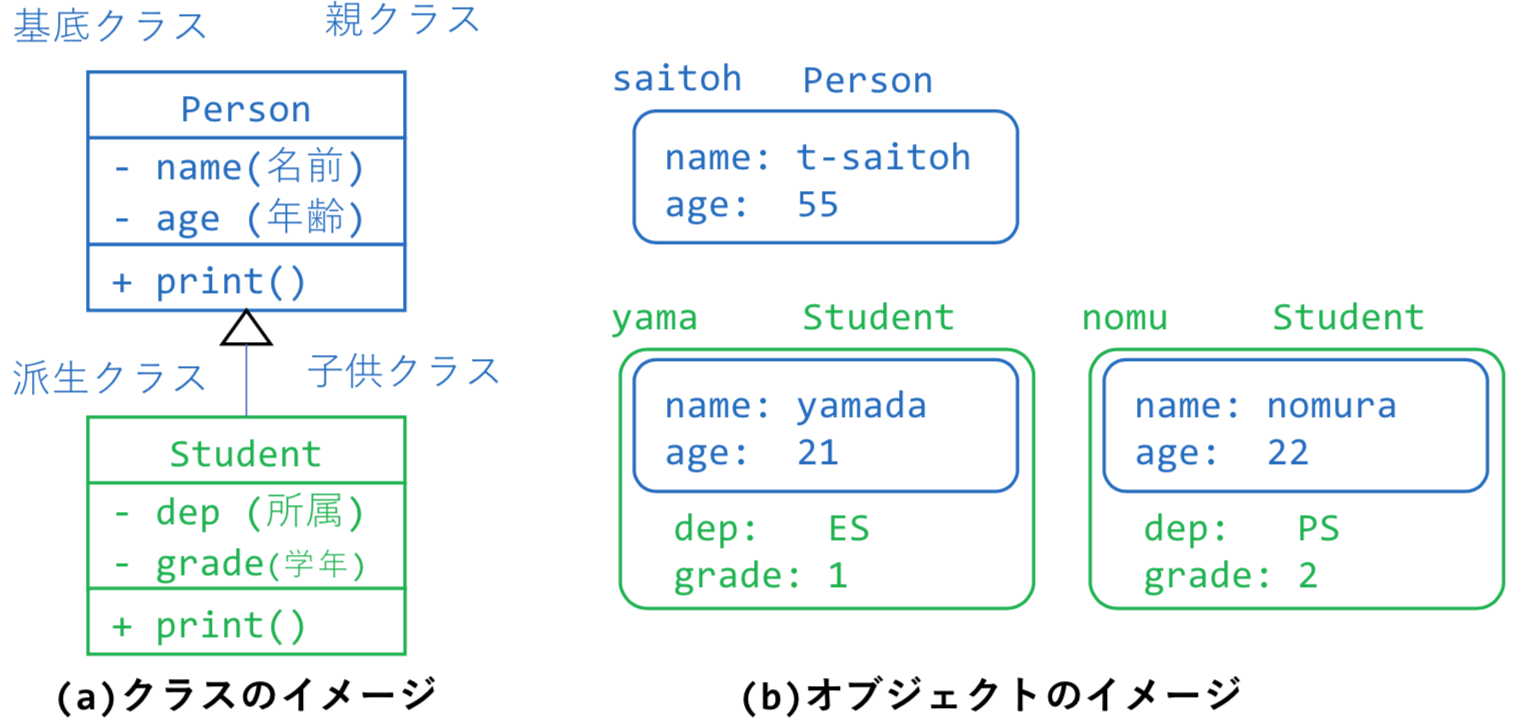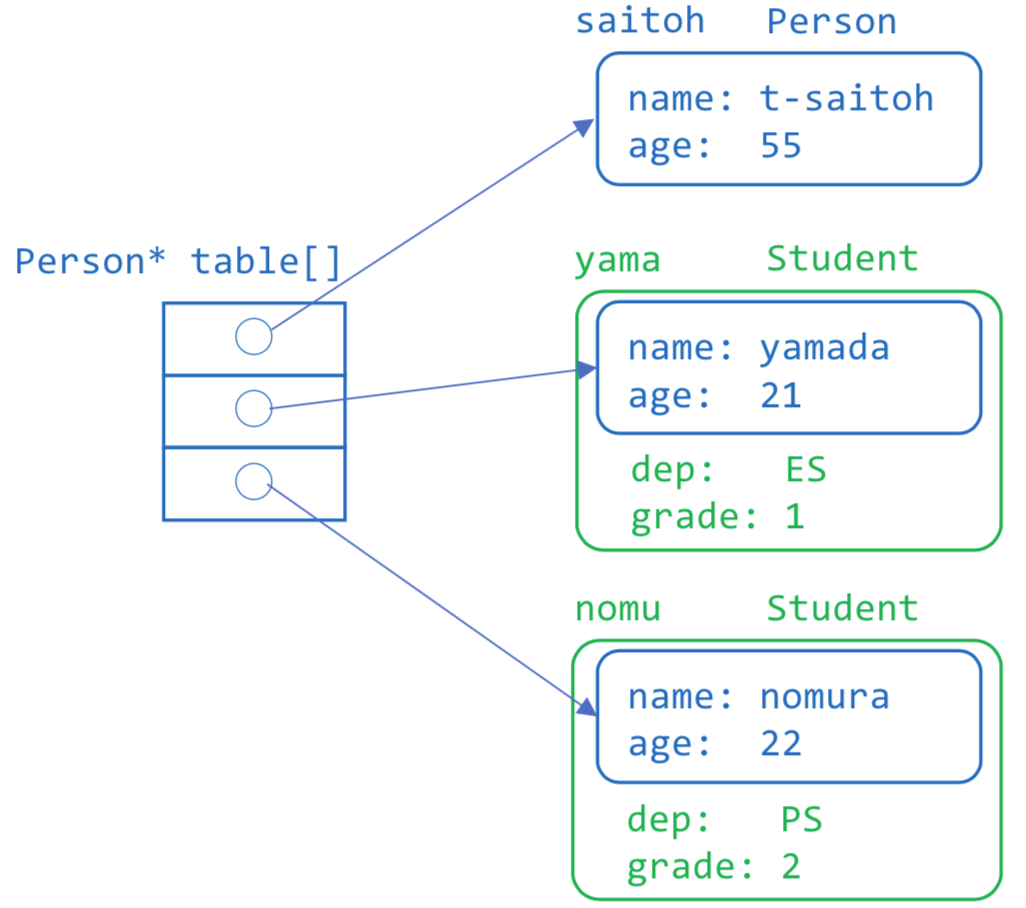前回の派生と継承のイメージを改めて記載する。
// 基底クラス
class Person {
private:
char name[ 20 ] ;
int age ;
public:
Person( const char s[] , int x )
: age( x ) {
strcpy( name , s ) ;
}
void print() {
printf( "%s %d\n" , name , age ) ;
}
} ;
// 派生クラス(Student は Person から派生)
class Student : public Person {
private:
char dep[ 20 ] ;
int grade ;
public:
Student( const char s[] , int x ,
const char d[] , int g )
: Person( s , x ) // 基底クラスのコンストラクタ
{ // 追加された処理
strcpy( dep , d ) ;
grade = g ;
}
void print() {
Person::print() ; // 基底クラスPersonで名前と年齢を表示
printf( "- %s %d\n" , dep , grade ) ;
}
} ;
void main() {
Person saitoh( "t-saitoh" , 55 ) ;
Student yama( "yamada" , 21 , "ES" , 1 ) ;
Student nomu( "nomura" , 22 , "PS" , 2 ) ;
saitoh.print() ; // 表示 t-saitoh 55
yama.print() ; // 表示 yamada 21
// - ES 1
nomu.print() ; // 表示 nomura 22
} // - PS 2
このような処理でのデータ構造は、次のようなイメージで表される。
派生クラスでの問題提起
基底クラスのオブジェクトと、派生クラスのオブジェクトを混在してプログラムを記述したらどうなるであろうか?
上記の例では、Person オブジェクトと、Student オブジェクトがあったが、それをひとまとめで扱いたいこともある。
以下の処理では、Person型の saitoh と、Student 型の yama, nomu を、一つの table[] にまとめている。
void main() {
Person saitoh( "t-saitoh" , 55 ) ;
Student yama( "yamada" , 21 , "ES" , 1 ) ;
Student nomu( "nomura" , 22 , "PS" , 2 ) ;
Person* table[3] = {
&saitoh , &yama , &nomu ,
} ;
for( int i = 0 ; i < 3 ; i++ ) {
table[ i ]->print() ;
}
}
C++では、Personへのポインタの配列に代入する時、Student型ポインタは、その基底クラスへのポインタとしても扱える。ただし、このように記述すると、table[] には、Person クラスのデータして扱われる。
このため、このプログラムを動かすと、以下のように、名前と年齢だけが3人分表示される。
t-saitoh 55 yamada 21 nomura 22
派生した型に応じた処理
上記のプログラムでは、 Person* table[] に、Person*型,Student*型を混在して保存をした。しかし、Person*として呼び出されると、yama のデータを表示しても、所属・学年は表示されない。上記のプログラムで、所属と名前を表示することはできないのだろうか?
// 混在したPersonを表示 for( int i = 0 ; i < 3 ; i++ ) table[i]->print() ; // Student は、所属と名前を表示して欲しい t-saitoh 55 yamada 21 - ES 1 nomura 22 - PS 2
上記のプログラムでは、Person型では、後でStudent型と区別ができないと困るので、Person型に、Person型(=0)なのか、Student型(=1)なのか区別するための type という要素を追加し、type=1ならば、Student型として扱うようにしてみた。
// 基底クラス
class Person {
private:
int type ; // 型識別情報
char name[ 20 ] ;
int age ;
public:
Person( int tp , const char s[] , int x )
: type( tp ) , age( x ) {
strcpy( name , s ) ;
}
int type_person() { return type ; }
void print() {
printf( "%s %d\n" , name , age ) ;
}
} ;
// 派生クラス(Student は Person から派生)
class Student : public Person {
private:
char dep[ 20 ] ;
int grade ;
public:
Student( int tp , const char s[] , int x ,
const char d[] , int g )
: Person( tp , s , x ) // 基底クラスのコンストラクタ
{ // 追加された処理
strcpy( dep , d ) ;
grade = g ;
}
void print() {
Person::print() ; // 基底クラスPersonで名前と年齢を表示
printf( "- %s %d\n" , dep , grade ) ;
}
} ;
void main() {
// type=0 は Person 型、type=1は Student 型
Person saitoh( 0 , "t-saitoh" , 55 ) ;
Student yama( 1 , "yamada" , 21 , "ES" , 1 ) ;
Student nomu( 1 , "nomura" , 22 , "PS" , 2 ) ;
Person* table[3] = {
&saitoh , &yama , &nomu ,
} ;
for( int i = 0 ; i < 3 ; i++ ) {
switch( table[i]->type_person() ) {
case 0 :
table[i]->print() ;
break ;
case 1 :
// 強制的にStudent*型として print() を呼び出す。
// 最近のC++なら、(static_cast<Student*>(table[i]))->>print() ;
((Student*)table[i])->print() ;
break ;
}
}
}
しかし、このプログラムでは、プログラマーがこのデータは、Personなので type=0 で初期化とか、Studentなので type=1 で初期化といったことを記述する必要がある。また、型情報(type)に応じて、その型にふさわしい処理を呼び出すための switch 文が必要になる。
もし、派生したクラスの種類がいくつもあるのなら、型情報の代入は注意深く書かないとバグの元になるし、型に応じた分岐は巨大なものになるだろう。実際、オブジェクト指向プログラミングが普及する前の初期の GUI プログラミングでは、巨大な switch 文が問題となっていた。
仮想関数
上記の、型情報の埋め込みと巨大なswitch文の問題の解決策として、C++では仮想関数(Virtual Function)が使える。
型に応じて異なる処理をしたい関数があったら、その関数の前に virtual と書くだけで良い。このような関数を、仮想関数と呼ぶ。
// 基底クラス
class Person {
private:
char name[ 20 ] ;
int age ;
public:
Person( const char s[] , int x )
: age( x ) {
strcpy( name , s ) ;
}
virtual void print() {
printf( "%s %d\n" , name , age ) ;
}
} ;
// 派生クラス(Student は Person から派生)
class Student : public Person {
private:
char dep[ 20 ] ;
int grade ;
public:
Student( const char s[] , int x ,
const char d[] , int g )
: Person( s , x ) // 基底クラスのコンストラクタ
{ // 追加された処理
strcpy( dep , d ) ;
grade = g ;
}
virtual void print() {
Person::print() ; // 基底クラスPersonで名前と年齢を表示
printf( "- %s %d\n" , dep , grade ) ;
}
} ;
void main() {
// type=0 は Person 型、type=1は Student 型
Person saitoh( "t-saitoh" , 55 ) ;
Student yama( "yamada" , 21 , "ES" , 1 ) ;
Student nomu( "nomura" , 22 , "PS" , 2 ) ;
Person* table[3] = {
&saitoh , &yama , &nomu ,
} ;
for( int i = 0 ; i < 3 ; i++ ) {
table[i]->print() ;
}
}
クラスの中に仮想関数が使われると、C++ では、プログラム上で見えないが、何らかの型情報をオブジェクトの中に保存してくれる。
また、仮想関数が呼び出されると、その型情報を元に、ふさわしい関数を自動的に呼び出してくれる。このため、プログラムも table[i]->print() といった極めて簡単に記述できるようになる。
関数ポインタ
仮想関数の仕組みを実現するためには、関数ポインタが使われる。
以下の例では、返り値=int,引数(int,int)の関数( int(*)(int,int) )へのポインタfpに、最初はaddが代入され、(*fp)(3,4) により、7が求まる。
int add( int a , int b ) { return a + b ; } int mul( int a , int b ) { return a * b ; } void main() { int (*fp)( int , int ) ; fp = add ; printf( "%d\n" , (*fp)( 3 , 4 ) ) ; // 3+4=7 fp = mul ; printf( "%d\n" , (*fp)( 3 , 4 ) ) ; // 3*4=12 int (*ftable[2])( int , int ) = { add , mul , } ; for( int i = 0 ; i < 2 ; i++ ) printf( "%d\n" , (*ftable[i])( 3 , 4 ) ) ; }仮想関数を使うクラスが宣言されると、一般的にそのコンストラクタでは、各クラス毎の仮想関数へのポインタのテーブルが型情報として保存されるのが一般的。仮想関数の呼び出しでは、仮想関数へのポインタを使って処理を呼び出す。このため効率よく仮想関数を動かすことができる。

